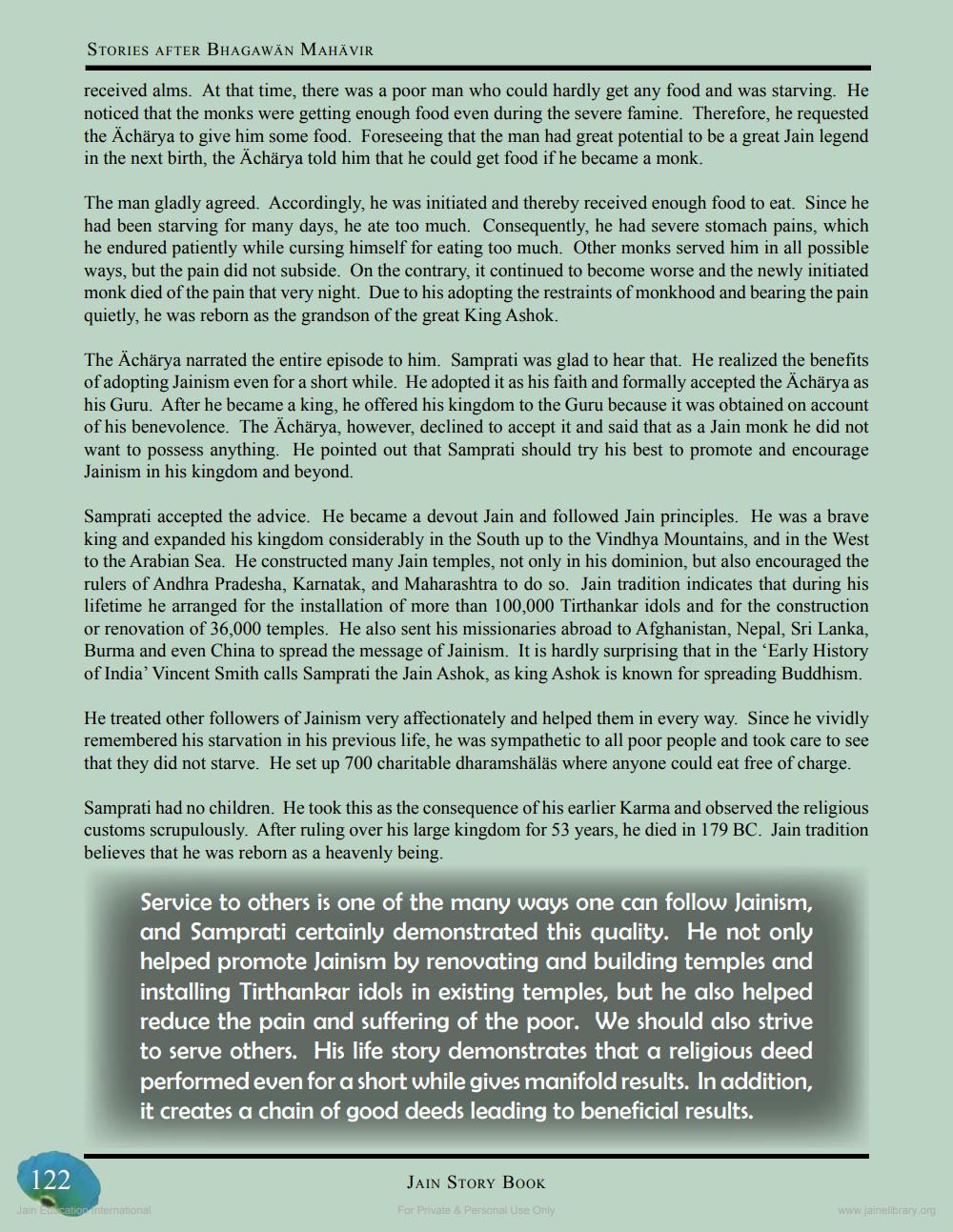________________ STORIES AFTER BHAGAWAN MAHAVIR received alms. At that time, there was a poor man who could hardly get any food and was starving. He noticed that the monks were getting enough food even during the severe famine. Therefore, he requested the Acharya to give him some food. Foreseeing that the man had great potential to be a great Jain legend in the next birth, the Acharya told him that he could get food if he became a monk. The man gladly agreed. Accordingly, he was initiated and thereby received enough food to eat. Since he had been starving for many days, he ate too much. Consequently, he had severe stomach pains, which he endured patiently while cursing himself for eating too much. Other monks served him in all possible ways, but the pain did not subside. On the contrary, it continued to become worse and the newly initiated monk died of the pain that very night. Due to his adopting the restraints of monkhood and bearing the pain quietly, he was reborn as the grandson of the great King Ashok. The Acharya narrated the entire episode to him. Samprati was glad to hear that. He realized the benefits of adopting Jainism even for a short while. He adopted it as his faith and formally accepted the Acharya as his Guru. After he became a king, he offered his kingdom to the Guru because it was obtained on account of his benevolence. The Acharya, however, declined to accept it and said that as a Jain monk he did not want to possess anything. He pointed out that Samprati should try his best to promote and encourage Jainism in his kingdom and beyond. Samprati accepted the advice. He became a devout Jain and followed Jain principles. He was a brave king and expanded his kingdom considerably in the South up to the Vindhya Mountains, and in the West to the Arabian Sea. He constructed many Jain temples, not only in his dominion, but also encouraged the rulers of Andhra Pradesha, Karnatak, and Maharashtra to do so. Jain tradition indicates that during his lifetime he arranged for the installation of more than 100,000 Tirthankar idols and for the construction or renovation of 36,000 temples. He also sent his missionaries abroad to Afghanistan, Nepal, Sri Lanka, Burma and even China to spread the message of Jainism. It is hardly surprising that in the 'Early History of India' Vincent Smith calls Samprati the Jain Ashok, as king Ashok is known for spreading Buddhism. He treated other followers of Jainism very affectionately and helped them in every way. Since he vividly remembered his starvation in his previous life, he was sympathetic to all poor people and took care to see that they did not starve. He set up 700 charitable dharamshalas where anyone could eat free of charge. Samprati had no children. He took this as the consequence of his earlier Karma and observed the religious customs scrupulously. After ruling over his large kingdom for 53 years, he died in 179 BC. Jain tradition believes that he was reborn as a heavenly being. Service to others is one of the many ways one can follow Jainism, and Samprati certainly demonstrated this quality. He not only helped promote Jainism by renovating and building temples and installing Tirthankar idols in existing temples, but he also helped reduce the pain and suffering of the poor. We should also strive to serve others. His life story demonstrates that a religious deed performed even for a short while gives manifold results. In addition, it creates a chain of good deeds leading to beneficial results. 122 JAIN STORY BOOK For Private & Personal Use Only Jain Education international www.jainelibrary.org




